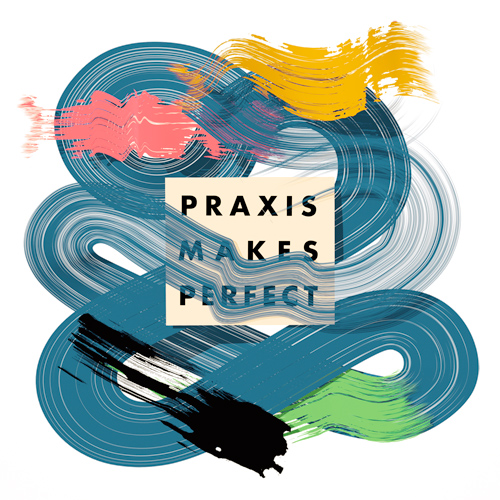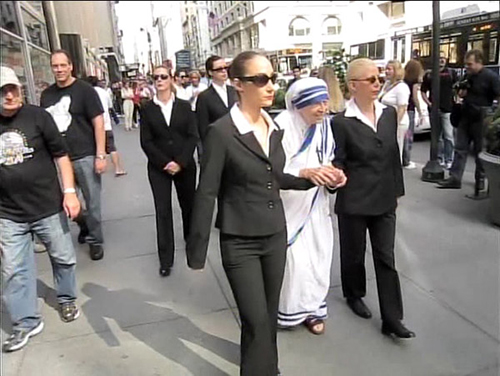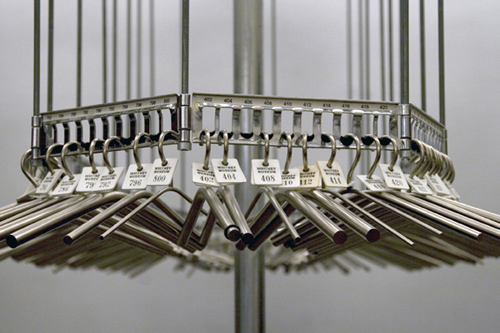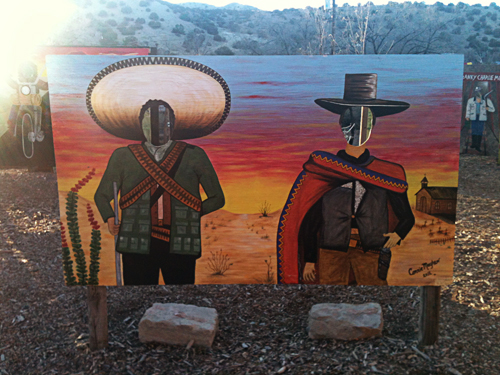
In the desert, time takes on a different dimension. Standing in its quiet expanse, time can slow until it virtually stands still. The open and meditative qualities of this landscape lure many in search of clarity and rejuvenation. It can provide a new framework to step into, featuring less of the static and perhaps a bit more of the rogue. But it is also a ritual-laden landscape, populated by stories of great sacrifice and journeys of long duration. Many religious traditions hold their own stories of prophets and sages who would “go into the desert” for substantial periods of time, charged with their spiritual work.
As I settle in to working in Santa Fe through the spring, I feel the effects of physical elevation in the high desert coupled with a heightened interest in ideas of ritual and duration as they relate to artistic practice. Being an artist affords a lifestyle that is liberating in its flexibility; the need for self-imposed structure can also be overwhelming. In examining the recent work of artists exploring these themes as a central tenet of their work, I am also investigating how related ideas might be applied behind-the-scenes in support of our own working methods.
It takes a special kind of woman to perch atop a scissor lift and sing Linda Ronstadt songs through a bullhorn for seven hours straight. Attending a recent opening at SITE Santa Fe, I happened upon the final hour of Linda Mary Montano‘s performance in one of the interior gallery spaces. For this event, titled Singing My Heart Out, viewers could watch and sing along with the artist as she ascended seven levels on a lift raised incrementally by the hour. Sitting beside her, a man in dark shades and a straw cowboy hat focused his attention on knitting, creating a long cord which extended to the ground in the beginnings of a coil–providing a physical document of the passing hours.
Montano’s work constitutes one of three interrelated exhibitions currently on view at SITE, all inspired by artistic production on the West Coast. The largest of these, State of Mind: New California Art Circa 1970, is a group survey exploring the emergence of Conceptual Art as it developed in California in the 1970s. While impressive, I gravitated towards two solo exhibitions complimenting the survey–a retrospective of work by Montano, and new work by Los Angeles–based artist Mungo Thomson, lauded as a “representative of the next generation of West Coast Conceptualism.”
Previously, I’d known little about Montano’s work beyond a series of bizarre performances involving chickens and a treadmill in San Francisco back in the 1970s. Admittedly, after seeing her performance on opening night and galleries of documentation, the adjectives campy and didactic still come to mind. But I respect the truth of intention in her work, strengthened by an awe-inspiring sense of commitment. Earnest in nature and relentless in approach, Montano explores the relationship between art and life by way of creating artistic rituals or ceremonies, some of which last for years. The artist often cites the influence of her strict Catholic upbringing on her work, discussing how her background and the related discipline of convent life (she spent a year in the Maryknoll novitiate) have helped her carry out the varied and disciplined performances of her career.
These performances include a year spent bound by rope to a Taiwanese performance artist named Tehching Hsieh for 24 hours a day (from July 4, 1983 to July 3, 1984). Shortly after, she began another ambitious project titled Seven Years of Living Art; each year, wearing monochromatic clothing and performing daily rituals corresponding to the colors and qualities of a specific chakra. During this same period, a curator at the New Museum built a private room for Montano, where she provided “Art/Life Counseling” for people once a month in a window installation painted in coordination with her clothing. More recently, the artist completed a series of three-hour performances at the Empire State Building, playing the role of Mother Teresa and flanked by look-alike female bodyguards based on Robert Palmer’s music video, “Addicted to Love.”

Linda Mary Montano Celebrates Mother Teresa’s Birthday at Empire State Building, 2010. Photo: Mark Shaw.
At the core of her work lies an interest in the ways these unusual rituals can alter and enhance lives, creating an opportunity to heighten awareness and eliminate the boundaries between art and life. In a 2012 interview with Brooklyn Rail, Montano discussed the role of artists as “journeyers and seers who are able to choose the right brain as a pathway, a vocation, and job description and, as a result, open the door to the sacred. Artists are called to not only hang out and be in the right brain but to invite the viewer to go there to have some relief from the pressures of everyday life.”
I recently read an insightful article about contemporary performance art by Amy Sherlock in The Weeklings. Referencing recent events staged at the Tate and MoMA by Tino Seghal and Marina Abramovic, respectively, she questions the validity of our supposed interest in performance art as an opportunity to have an experience “with” something authentic. Sherlock argues that the very idea of performance as such seems counter-intuitive, as its very identification as art distinguishes its existence as a “stylized, hyper-codified way of acting and interacting.” She agrees that while real life can be reduced to a series of daily rituals and performances, performance is conflicted in the promise of a personal exchange since it relies on a repeatable and rehearsed formula.
With respect to current trends in performance art, I largely agree with Sherlock. But in the context of Linda Mary Montano’s work, I would argue that her approach defies such trends as she employs honest transparency in an effort to help viewers incorporate simple yet transformative rituals or actions into their own lives. In the text accompanying a series of drawings collectively titled Learning to Fly, the artist discusses the struggles of leaving graduate school and feeling a lack of grounding. In response, she began drawing her feet and legs, an exercise in focusing attention and calming moments of self-critique as she embarked on a teaching career. She invites viewers to examine related events in their own lives, suggesting tactics to help achieve a more grounded state.
Though of a different generation, these issues remain for the vast majority of artists. I am one among many who are learning to balance freelance jobs and short-term contracts with research, fieldwork, and a constant flow of applications waiting in the wings. In negotiating this process, I recognize the importance of finding my own rituals to depend on. Some days, the consistency may be nothing more than waking up and staring out the window for a few moments as I drink a cup of coffee. But even here, increased focus on setting intentions can be helpful as we consider how daily practices and small actions can benefit our work and life.
Walking through the SITE galleries that featured Mungo Thomson’s work, I spent a considerable amount of time staring at what appeared to be an institutional room divider. The “aha” moment came when a woman walked up to the partition and pushed it towards the wall, activating the reed mechanics of an accordion. It was both understated and delightful. As I learned, Acoustic Partition is one of Thomson’s new works and a follow-up to his project for the 2008 Whitney Biennial. It was there that the artist installed Coat Check Chimes, replacing all of the existing coat hangers in the Whitney Museum’s coat check with custom-made “tuned” hangers. In the process of conducting business as usual, coat check attendants created a program of music inspired by chance.

Mungo Thomson, “Coat Check Chimes,” 2008. Nickel-plated aluminum and steel, dimensions variable. Installation view, 2008 Whitney Biennial. Photo: Joanne Kim.
Looking at the organization of daily life and infrastructure of museums and related institutions, Mungo Thomson torques and elevates their components. Though using a radically different approach than Montano, he is also blurring the lines between life and art. In Thomson’s case, he employs thoughtful subtleties and wit in drawing attention to the framework of our experience and those rituals we come to expect in the negotiation of space.
As part of the 2011 exhibition Nothing Beside Remains curated by LAND (Los Angeles Nomadic Division) in Marfa, Texas, Thomson produced a magazine called People based on the aesthetic of typical tabloids, featuring snapshots of art patrons at an array of galleries, museums and art fairs. Throughout, all of the artwork has been removed, leaving only the audience. Picking up a free copy of People in one of the galleries, attention to its clever design was trumped by my own thoughts related to our collective experience of viewing art, an important ritual all its own.
Examining the work of Linda Mary Montano and Mungo Thomson, I find inspiration in different aspects of their approaches. In the case of Montano, a committed and earnest approach is complimented by the clear perimeters set in her work. Mungo Thomson reveals the perimeters and habits that already exist, encouraging us to reexamine and deepen their potential functions. At their core, both encourage a raised sense of awareness as a vital part of the process.
Perhaps the tougher question is how to stay committed to these perimeters? Whether you’re an artist interested in durational projects or an artist aiming to keep regular studio hours, I think both the crux and the answer lie in the lessons of the desert. This open and exposed landscape is populated by less, yet tests its travelers with more. The elements can be harsh, and the silence can be deafening. The key, I think, is recognizing that less is more. By taking the time to honestly examine our current patterns and the changes we want to make, we can start by creating a simple set of perimeters and sticking to them. Keep showing up, keep doing the work.

On Kawara, from the “Today” series, 1973.
Such an approach reminds me of the Today series by Japanese artist On Kawara. In creating his first date painting on January 4, 1966, Kawara began an ongoing, open-ended body of work with pieces now numbering in the thousands. Almost every day, the artist starts a new painting, recording the date; if he does not finish the canvas that day, it is destroyed. I like the idea of this meditative approach to concepts of time, place, and consciousness. Every morning, as I drink my coffee and watch the shadows move across these adobe walls, I am reminded of an elemental truth: even in its quietest moments, time stands still for no one.





Pingback: Week in Review 03.02.13 | Art21 Blog